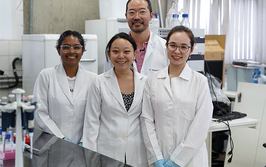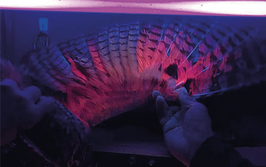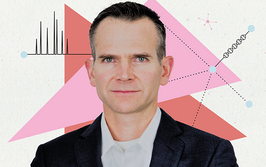Carving Out an Analytical Niche
Sitting Down With... Renã Robinson, Assistant Professor, Department of Chemistry and Principal Investigator at RASR Lab, University of Pittsburgh, Pennsylvania, USA.
How did you get into analytical chemistry?
As part of my undergraduate chemistry research, I used GC-MS and LC-MS to detect fatty acids in glaucoma. It was my first exposure to using mass spectrometry for biological applications – and I was immediately excited by the possibilities. At Indiana University, I chose a dissertation project using analytical mass spectrometry methods to study proteins and aging in fruit flies. I used ion mobility-MS, which added another dimensionality to the data, increasing the separation space and allowing me to see more low-concentration proteins. It was a very interdisciplinary, collaborative research project, and everything was new to me – from the genetics of fruit flies to sifting through massive amounts of proteomics data to get something meaningful. It was exciting to be working in the field in the mid-2000s, when proteomics had just started to become a big deal.

How has proteomics changed since then?
The field has moved from establishing initial methods to measure proteins, to advancing instrumentation in such a way that allows us to profile entire proteomes with incredible sensitivity, and detect differences in diseased and healthy individuals. We have gotten really good at quickly analyzing the resulting data and focusing on the functional implications for proteins. The question now is: how can we analyze dynamic networks, and use spatial and temporal information in the best way to advance research?
Where did your research take you after your PhD?
Collaborating with a colleague who was working on Parkinson’s disease sparked my interest in the possibilities of applying MS in age-related diseases. I have personal connections to Alzheimer’s disease (AD), and wanted to dig deeper into the mechanisms behind neurodegeneration. I started looking for postdoctoral opportunities where I could focus more on age-related pathology. One universal aspect of aging is a decline in the immune system, which led me to focus my work on the role of immunosenescence in age-related disease.
What are your current projects?
We’re using Orbitrap technology – very high-resolution and sensitive mass spectrometers – to carry out multiplexing experiments (MS, then MS/MS, and then MS/MS/MS) investigating how proteins change during aging and immunosenescence, and looking for potential drug targets in neurodegenerative disease. It’s exciting work – we’re seeing things that have never been seen before. For example, we have been able to determine that the liver plays a significant role in Alzheimer’s disease by identifying many proteins with different expression in AD mouse models compared to wild-types. Additionally, we have begun to better understand the effects of oxidative stress in AD by measuring nitrated and S-nitrosylated proteins. While we are aware that AD is a brain disease, we have significant proteomics data to show that peripheral organs also have an important role. Our current projects are geared towards understanding the system-wide nature of AD and determining if there are systems which make certain populations more at risk for developing AD.
What motivates you?
It’s a gift and a privilege to be doing this type of research; I feel like this is my purpose. The thought of all the people who are being left devastated by AD keeps me focused. It reminds me that we need to aim for more than just incremental improvements in our technology and analytical approach – there’s a bigger picture that we have to keep in mind.
What’s next for your lab?
Our lab is moving to Vanderbilt University this summer. There are lots of opportunities at Vanderbilt to do really top-notch mass spectrometry – and to engage with the Memory & Alzheimer’s Center to help further research in this area. We’ll be able to add to our repertoire of approaches and techniques, and beef up our mass spec platforms and technologies. As well as proteins, we’re interested in measuring lipids and other metabolites. The team already has a lot of analytical expertise, but we’re planning to expand our capabilities in informatics and functional biology, to allow us to follow up on our proteomics findings. We’re particularly excited to have more access to human samples in the clinic. In ten years’ time, I hope we will have been able to help advance AD research – and be one step closer to an effective treatment.
Congratulations on winning a 2017 Pittsburgh Conference Achievement Award…
It was a real highlight, especially to be presented the award by Sarah Trimpin (now at Wayne State University). Sarah has been a mentor to me since she was a postdoc and I was a PhD student at Indiana. She showed me how to push away at a problem and give it everything I’ve got! She works extremely hard and extremely smart; not only has she done so much with ionization techniques and mass spectrometry, but she also considers every angle that you could to approach a particular problem. She has carved out a niche for herself, and inspired me to ask myself, “What’s going to be my thing?”
And what is your “thing”?
I hope I’ll be able to look back at my career and say my niche was developing and applying quantitative proteomics in a way that has furthered our understanding of AD and aging – specifically, how things outside of the brain are related to what’s happening in the brain. From the start, I knew I wanted to take on a problem in human health, and use my analytical skillset to help answer that problem.
Associate Professor of Chemistry, Dorothy J. Wingfield Phillips Chancellor’s Faculty Fellow, Department of Chemistry, Vanderbilt University, and Department of Neurology, Vanderbilt University Medical Center; Leader of Outreach, Recruitment, and Engagement, Vanderbilt Memory and Alzheimer’s Center; Training Faculty, Vanderbilt Brain Institute, Vanderbilt Institute of Chemical Biology, Vanderbilt University, Tennessee, USA; NOBCChE President-Elect.

















